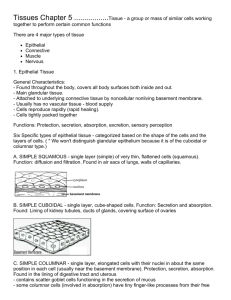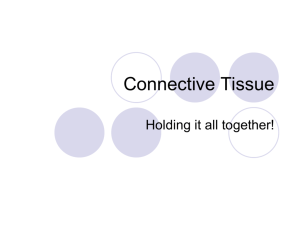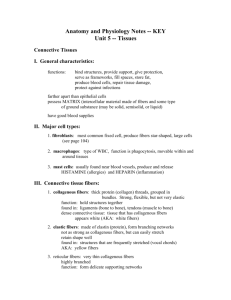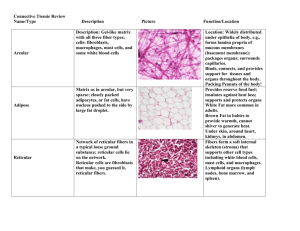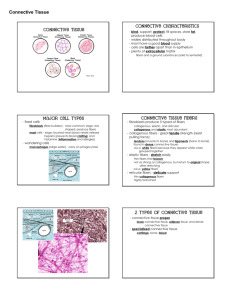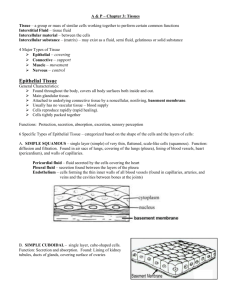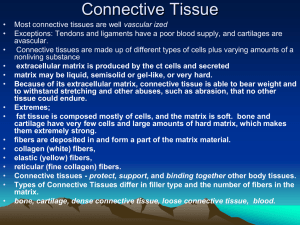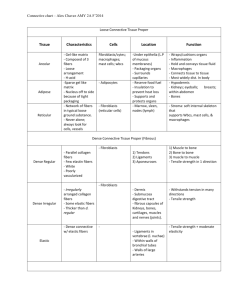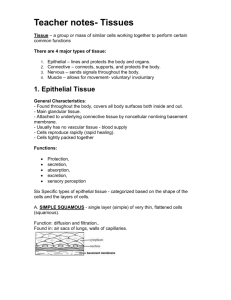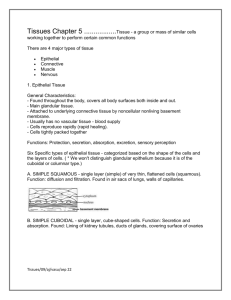Connective Tissue
advertisement
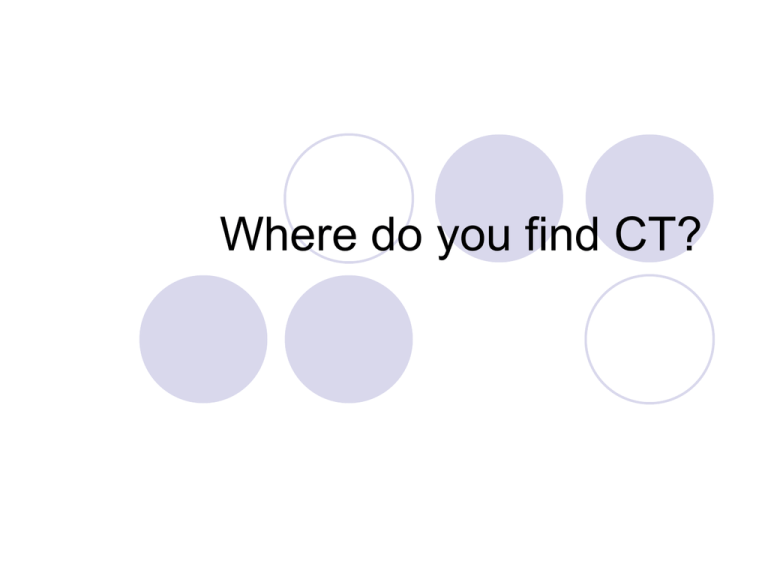
Where do you find CT? What are the fibers in CT? What cells hang out in CT? Connective Tissue Holding it all together! Connective tissue is found everywhere! Main types: 1. Connective tissue proper – We will focus on this one most of next week! 2. Cartilage 3. Bone 4. Blood Properties 1. common origin Mesenchyme Mesenchyme is an embryonic tissue From the mesoderm Ectoderm Endoderm 2. degrees of vascularity 3. great degree of “non-living” extracellular matrix What do we mean non-living? Connective Tissue – essential functions 1. 2. 3. 4. 5. Binds structures Provides support and protection Insulation Transportation Energy storage Structural elements: 1. Ground substance (matrix) 2. Fibers 3. Cells Wide range of varying tissue! Different structuresdifferent functions! Ground Substance (matrix) Unstructured material Fills spaces/contains fibers Composed of: 1. interstitial fluid 2. cell adhesion proteins glue like function 3. Proteoglycansprotein core (point of attachment) “GAGs” glycosaminoglycans 1. (interlock trapping water) Major Cell Types: Blasts vs. Cytes Fibroblasts- cells that produce fibers by secreting proteins into the matrix of CT tissue Macrophages- originate as WBCs specialized cell phagocytosis Mast Cells- release heparin prevents blood clotting, release histaminepromotes reactions associated with inflammation and allergies. Fibroblast—laying matrix CONNECTIVE TISSUE-3 FIBER TYPES A. Collagenous fibers- Thick threads of protein (collagen) Grouped in long parallel bundles, they are flexible, but only slightly elastic. Great tensile strength (ligaments and tendons) B. Elastic fibersComposed of protein elastin These fibers branch, forming complex networks. weaker than collagenous fiber however they stretch and can return back to there shape Elastic Fibers C. Reticular Fibers Very thin collagenous fibers Highly branched, form supporting networks (LIKE A NET) Reticular Fibers When it comes to CT you can have a variety of types…. Loose CT 1. areolar tissue 2. Reticular tissue 3. Adipose tissue Dense Regular Irregular Cartilage types I. Loose Connective Tissue Forms delicate thin membranes throughout the body Main cellFibroblasts separated by a gellike matrix Binds skin to underlying organs and fills spaces between muscles Lies beneath epithelium 2 Adipose Tissue FAT, develop when certain cells store fat in droplets within their cytoplasm. Beneath the skin, stored in many other locations as well. Cushions, insulates, stores energy. 3 Dense Connective Tissueregular or irregular Closely packed, thick, collagenous fibers and a close network of elastic fibers. Relatively few cellsmost of which are fibroblasts. VERY STRONG TISSUE 4 Cartilage Rigid CTprovides support, frameworks, and attachments, protects underlying tissue forms structural models for developing bone. Cartilage matrixabundant, largely composed of colagenous fibers embedded in a gel-like ground substance . Cartilagea special case SPECIAL CARTILAGE CELLS CHONDROCYTES, occupy small chambers called lacunae Cartilage structures are enclosed in a covering of CTperichondrium (contains the blood vessels that deliver nutrients) THE INTERCELLULAR MATRIX DISTINGUISHES THE TYPE OF CARTILAGE! Hyaline Cartilage *most common type *very fine collagenous fibers (looks like white glass) Location: end of bones, joints, soft part of nose, trachea Elastic Cartilage Dense network of elastic fibers Much more flexible than hyaline cartilage Location: framework of ear, parts of larynx Fibrocartilage Tough tissue, contains many collagenous fibers -shock absorber for structures subjected to pressure. Location: vertebrae (discs), knees, pelvic girdle.

